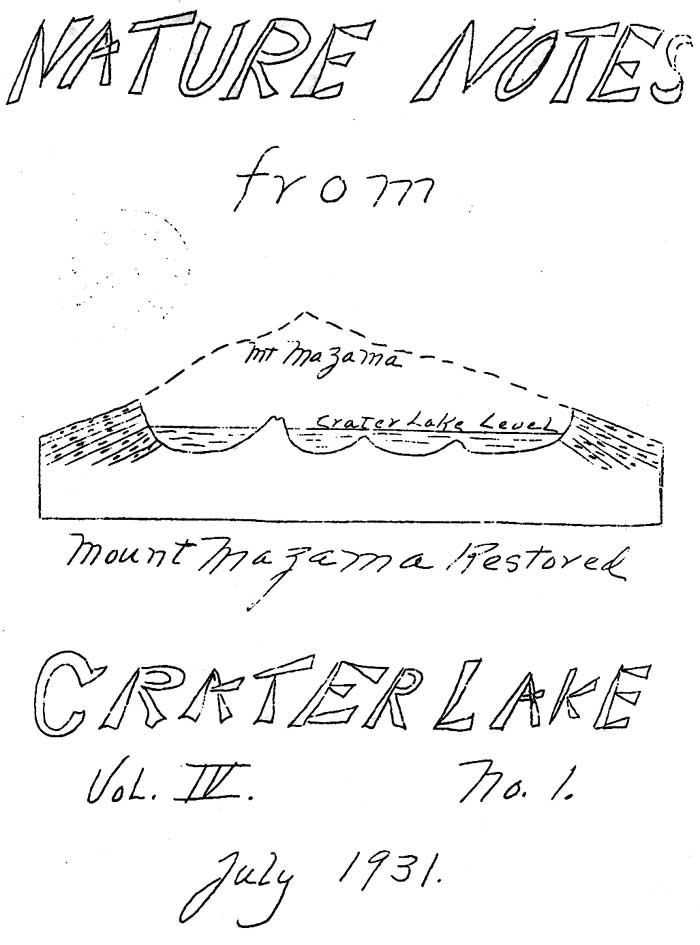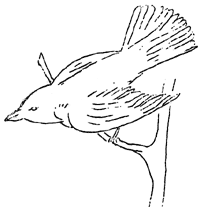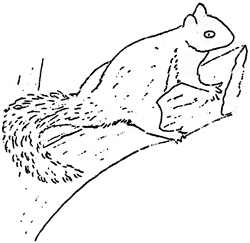Volume 4 No. 1 – July 1, 1931
All material courtesy of the National Park Service.These publications can also be found at http://npshistory.com/
Nature Notes is produced by the National Park Service. © 1931
Come up the mountain to Crater Lake and behold the limpid deep blue of the waters in their varying moods! To you who have bided a time on the rim or have followed the trail down to the water’s edge; to you who have scaled the nearby peaks and communed with the birds and the flowers — we know there is a call beckoning your return again and again.
The same sense of awe which strikes one spellbound when he first views Crater Lake will recur. The mystery of this lake of lakes creates an undeniable urge to return as opportunity may permit. As the views vary from hour to hour and from day to day, they vary from season to season as the angle of light changes with the movement of the points of sunrise and sunset northward and southward along the horizon.
To the visitors of past seasons as well as to those who will come up to Crater Lake for the first time, we extend cordial greetings. This season the roads were cleared of snow so that visitors came up to the rim as early as April 1 — the earliest date in the history of the park.
Camp fires are dotting the base of the moraine and nightly there are many at the Community House and the Lodge attending the lectures concerning the natural phenomena of the park.
In this issue we wish to introduce the members of the Educational Staff for the 1931 season.
Mr. Earl U. Homuth, who has served splendidly in the naturalist service in the past, is again a member of the force; Dr. W. Layton Stanton, Jr., from California Institute of Technology and Mr. Lincoln Constance, a graduate of the University of Oregon, who is engaged in graduate study in the University of California, are beginning their activity in a particularly enthusiastic and efficient manner.
This promises to be the season which will bring a record number of visitors to be inspired and recreated by our majestic scenery and climate.
Birds
By Don C. Fisher, Park Ranger
A list of birds seen in the park has been kept and added to from time to time as a new bird appeared in the park area until last year the number of birds seen in the park was seventy-six. Already this year a stranger has been added to the list. The latest addition being the Mourning Dove (Zenaidura macroura). The dove is essentially a bird of the fields and how they have drifted into wooded areas of the park is a question that is both interesting and surprising.
Members of the various crews have reported many nests of the Ruffed grouse (Bonasa umbellus) and also the Sooty grouse (Dendragapus obscurus) more commonly known as the Blue Grouse.
Perhaps the most unlucky of the forest residents of the park is a pair of Mountain Robins who have resided at Annie Spring for a number of years. They have selected a tree near the spring for the site of their nest and each year have reared their brood. Last summer one of the rangers on duty heard the birds making a great commotion and walked over to the tree. The birds were all a flutter and would hop from limb to limb and then swoop down at something that the ranger could not see. Finally the ranger began to climb the tree and just as he reached the nest a frightened pine squirrel scampered down the tree and away to another clump of trees. Several times afterward the squirrel was soon going or coming from the nest.
This spring the two birds, undaunted by the tragedy of last summer, returned and again took up their home in the same tree. All went well until one morning a great noise arose in the vicinity of the nest and on examination the ranger found that a large raven had settled near the nest and was attacked by the robins who forced it to leave but, however, no sooner did the parent birds return to the nest than the raven swooped down to the nest and seemingly unmindful of the robins, robbed the nest and departed. Thus the law of nature takes its course and the rangers wonder if the robins will return again next spring.
Of the seventy-six birds known to inhabit the park, only five care to stay here the year round. During the summer months the woodlands ring with the songs of the feathered inhabitants but when the old man winter comes creeping into the trees most of the songsters depart for lower elevations.
The five who are here all winter are Stellar Jay, (Cyanocitta stelleri), Oregon Jay(Perisoreous obscurus), Raven (Corvus corax)), Clarks Crow (Nucifraga columbiana),and the Red-breasted Nuthatch (Sitta canadensis).
In the spring the first of the migrants to return are Pine Siskin (Spinus pinus), Western Robin (Planestincus Migratorius propinquus), Mountain Blue Bird (Sialia currucoides),and the Oregon Junco (Junco oreganus).
Carbonized Wood: An Index From the Past
By D. S. Libbey
Recently there have been found several large logs which are completely buried under an overburden of volcanic tuff and agglomerate. Some of the logs exceeded fifty feet in length and they were found resting in a horizontal position without any evidence of roots or stumps. Also there were no small branches attached to the logs but several small branches found detached indicative that both the logs and the smaller branches had probably floated to the place where they were subsequently covered by the heavy burden of volcanic material. The depth at which these logs were found in the volcanic tuff varied from 22 to approximately 60 feet with the conditions thoroughly indicating that there had been no disturbance since the time of their entombment.
The site of this find is about 23 miles directly west from the Rim of Crater Lake along the banks of the Rogue River where excavation by a steam shovel is being made on the now Diamond Lake Road just above Union Creek. The carbonized wood is unquestionably found in-site and the volcanic material – ash and pumice – apparently at some time in the past had completely dammed the Rogue River and caused a reservoir or a lake to be formed. Subsequently the Rogue has worn its channel through the deposit of fragmental material and is now resting upon a vesicular lava rock.
This material has an exceedingly interesting story to tell. The material was buried under a thick overburden of consolidated volcanic ash and pumice and is completely turned to charcoal. The logs necessarily were entombed under very thick loads of hot ashes and the heat, coupled with the rapidity in which the volcanic ejecta fell, resulted in the oxygen of the air being excluded which is essential to prevent combustion of entombed wood. As a result the wood material was changed to carbonized wood or natural charcoal. Such material is capable of preservation indefinitely and its presence can be discovered even thousands or even millions of years later.
The presence of charcoal buried in the midden heaps where prehistoric man abided is one of the most certain means to prove the existence of early human habitation. This is mentioned in order to illustrate the degree to which charcoal is indestructible under normal conditions and that it is such a splendid time marker by which the record of the past may be read.
The carbonized wood being buried under volcanic ejecta, ashes and pumice necessarily forces the conclusion that a very terrific volcanic explosion occurred to bury and carbonize the logs. The fact that the logs were changed to natural charcoal forces the conclusion that the ash and pumice was still exceedingly hot when it came to rest. The volcanic tuff was found in several places to be interbedded with water laid sand and gravels of a heterogeneous nature, suggesting a lake deposit in which glacial material was deposited and also the very definitely cross-bedded strata suggest off-shore conditions.
A complete assortment of the material is being preserved and a record being made of the essential facts concerning the find, so that we may correlate this find with subsequent discoveries of fossil wood, carbonized vegetation or any other material which may be subsequently found. This will enable the scientific investigators to piece together a coherent story concerning the origin of Crater Lake and possibly lend more data to prove or disprove the several theories which are prevalent concerning the destruction of old Mount Mazama. Did the cone of Mount Mazama collapse and then subsequent eruption build up the three volcanic cones now found within the caldera? Did a terrific explosion blow of the top of Mount Mazama, leaving the gigantic caldera which Crater Lake occupies and subsequent eruption build up the volcanic cone of Wizard Island and the two smaller cones which are of insufficient height to protrude above the water level of the lake?
Did the volcanic ejecta, ash and pumice, which buried the logs and changed these to charcoal, come from the eruption of Mount Mazama prior to its final collapse or explosion? Did the ejecta come forth at the time of Mount Mazama’s final destruction? Is the ejecta in question the explosive material of some adnate volcanic cone rather than material erupted from Mount Mazama? All of these questions are easier to ask than to answer. In our small way it is our hope to accumulate the evidences of the past as we are able to discover them and thus be able to piece together the correct story by eliminating the less probable hypothesis.





